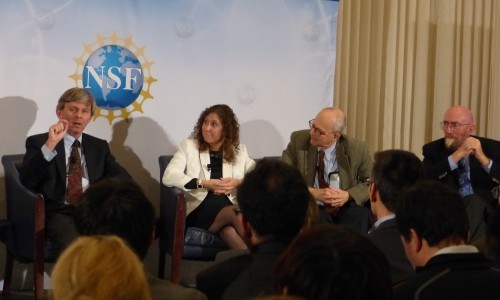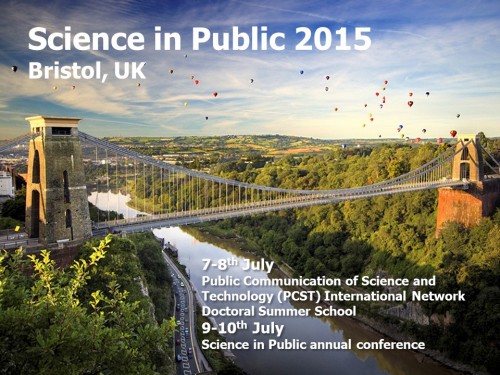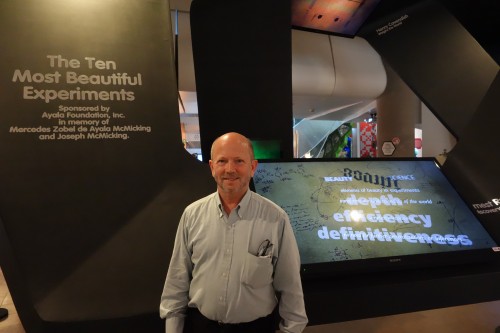Tag archives: science communication
From physics degree to Hollywood
By James Dacey
This summer many of you will watch smoke billowing out of buildings as yet another villain wreaks havoc on the New York skyline in the latest Hollywood blockbuster. I’m willing to bet that as you eat your popcorn you won’t be thinking about the Navier–Stokes equations of fluid dynamics. (Well, perhaps you will now that I’ve mentioned it!)
In fact, part of the reason that virtual smoke in films looks so realistic is because visual effects (VFX) specialists have applied the Navier–Stokes equations to their graphics. This was one of the interesting tidbits I learned from a talk yesterday in London by Rob Pieké, head of software at Moving Picture Company (MPC).
Pieké was speaking as part of a half-day event on “physics and film” organized by the Institute of Physics, which publishes Physics World. The gist of his presentation was that basic physics principles are used in a variety of ways to create special effects that capture viewers’ attention. “The audience wants to see something fantastical but grounded in reality,” said Pieké. Another example he gave was how naturally bouncing hair in computer-generated characters is modelled on mass—spring systems. Each individual hair could be modelled on as many as 30 masses connecting by springs.
View all posts by this author | View this author's profile
Behind the fence of a closed atomic city in Russia
By James Dacey
The European première of a documentary recorded secretly within a Russian “atomic city” is among the highlights at Sheffield Doc/Fest, the international documentary festival that gets under way tomorrow in Sheffield, UK. City 40, directed by the Iranian-born US filmmaker Samira Goetschel, takes viewers inside the walls of a segregated city established by the Soviet Union during the Cold War as a guarded location for developing nuclear weapons.
The social model in Ozersk (formerly known as City 40) is reminiscent of what occurred in Richland, the US city near the Hanford site in Washington State where plutonium was produced for the “Fat Man” bomb that was detonated over Nagasaki, Japan. In both these US and Soviet cities, the citizens were lavished with higher-than-average salaries and standards of living, such as quality housing, healthcare and education systems. Today, Ozersk is still a closed city with an alleged population of 80,000 and exists officially as a facility for processing nuclear waste and material from decommissioned nuclear weapons.
View all posts by this author | View this author's profile
How to cook the perfect steak, Bill Nye gets tangled about entanglement and the challenges of going to Mars

The wrong way: where is the liquid nitrogen and duck fat? (CC BY 2.0 _BuBBy_)
By Hamish Johnston
How do you cook the perfect steak? Materials scientist Mark Miodownik of University College London has the answer. To cook his medium-rare steak (pink in the middle with a seared coating on the outside), Miodownik first seals the steak in a vacuum bag and places it in a warm water bath until it reaches 55 °C. He then dips it in liquid nitrogen for 30 s to chill the outer layer without freezing the middle. If that wasn’t unconventional enough, he then throws it into a deep-fat fryer containing duck fat. The result? “A lusciously seared steak, medium rare all the way through. And not a pan in sight!” says Miodownik. The BBC has put together a nice animation of the recipe: “What’s the weirdest way to cook a steak?”.
Science that goes ‘chirp’ in the night

LIGO leaders at the press conference (from left): executive director David Reitze, spokesperson Gabriela González, Rai Weiss and Kip Thorne.
By Margaret Harris at the AAAS meeting in Washington DC
Not with a bang, but a chirp.
That’s how the 2016 meeting of the American Association for the Advancement of Science (AAAS) kicked off on Thursday, thanks to the spectacular news that the Laser Interferometer Gravitational-wave Observatory (LIGO) has, for the first time ever, directly observed the ripples in space–time known as gravitational waves. As our news story explains, LIGO’s twin interferometers picked up the waveform produced as two black holes spiralled into each other, emitting gravitational waves at frequencies and amplitudes that rose sharply with time, like the chirp of a cricket.
The LIGO researchers announced their discovery at a packed press conference in downtown Washington, DC. The excitement in the room was palpable, even though, as it turned out, most of the journalists present already knew what they were about to hear. This actually isn’t unusual. It’s common practice for scientific journals to send new research papers to journalists a few days ahead of publication; the idea behind this so-called embargo system is that it gives journalists time to report accurately on complex science stories.
What was unusual was that this time, there was no embargoed paper. Instead, there was a vigorous rumour mill casting out information in a messy, somewhat underhand and highly anisotropic way. This is rather interesting, and I wish that LIGO’s Gabriela González hadn’t dismissed the journalist who asked about it with an incredulous “The facts are so beautiful – why do you talk about rumours?”
Settling scientific disputes in public

By Margaret Harris
Here’s a Tuesday quiz for you. If you disagree with a colleague about something scientific, what should you do? Your choices are:
(a) Nothing. This is science, and the truth will win out no matter what I do;
(b) Take them aside and explain, privately, why you think they are wrong. Then, if they still disagree with you, get even by writing snarky anonymous reviews of their papers;
(c) Organize a panel “discussion” and tear them to shreds in front of all your colleagues;
(d) Take your case to the public by writing a popular-science book explaining the superiority of your own theory.
Okay, this is a trick question: I’m not sure any of those options is really a good idea (although I’m sure they’ve all been tried). I’d like to focus on the last one, though, because it was the subject of an interesting talk at the Science in Public conference, held last week in Physics World’s home city of Bristol.
View all posts by this author | View this author's profile
The museum exhibit that you inspired

Inspired thinking – Robert P Crease in front of an exhibit at Manila’s Mind Museum that was inspired by Physics World readers.
By Robert P Crease in Singapore
It’s not often that you come across a museum exhibit based on a Physics World article. But I did on Saturday at the Mind Museum – an extraordinarily beautiful and original science museum in Taguig, on the outskirts of Manila in the Philippines.
Not only that, the exhibit is right at the entrance. You may recall that I once asked Physics World readers for their thoughts on the 10 most beautiful experiments and wrote up the results in an article in September 2002. The project turned into a book, The Prism and the Pendulum: The Ten Most Beautiful Experiments in Science, which came out the following year and which Physics World reviewed.
Maria Isabel Garcia, who was planning exhibits for the then-future Mind Museum, saw the article and book, and created an exhibit based on it, consisting of videos and explanations of each of the 10 experiments, along with a sculpture designed by the Philippine artist Daniel de la Cruz.
What makes a physics experiment go viral?
By Tushna Commissariat
Physics experiments are not normally the stuff of “viral” videos on the Internet, but that is precisely what happened when physics students at the University of Bath in the UK decided to get creative with the Leidenfrost effect. If you are a regular reader of Physics World, you may get that déjà vu feeling when you watch the video above of water droplets zipping about the “Leidenfrost maze” built by (at the time undergraduates) Carmen Cheng and Matthew Guy – but rest assured you have seen it right here on this blog in 2013 when editor Hamish Johnston wrote about it before it amassed a whopping 120,150 views on YouTube.
View all posts by this author | View this author's profile
Promoting better science journalism
By Margaret Harris
Some people fear public speaking more than illness or death. I’m not one of them, but I’ll admit to some qualms on Monday morning, when I travelled to the University of Westminster to speak about science to a group of journalism students.
As I rode the Metropolitan Line train up to Westminster’s Harrow campus, I wondered what sort of speaker the students were expecting. I was giving the talk as part of a Royal Statistical Society (RSS) programme to train journalists in basic statistical principles and how science works; however, unlike most of the people involved in the programme, I am neither a professional scientist nor a statistician. Moreover, the official RSS curriculum places a strong emphasis on statistics and scientific practices in medical science, which isn’t exactly my strong suit either. So while I knew the programme was aimed at helping non-specialists understand basic concepts like risk, the scientific method and the role uncertainty plays in science – all topics that I’m fairly comfortable with – I couldn’t help feeling like a bit of an imposter.
Prizewinning book gives materials science a chance to shine
By Margaret Harris

Mark Miodownik last night.
Materials scientist and first-time popular-science author Mark Miodownik was all smiles last night as his book Stuff Matters scooped one of the UK’s top non-fiction awards, the Royal Society Winton Prize for Science Books. The book, an engaging and often highly personal look at some of the everyday materials that make modern civilization possible, was the unanimous choice of the five-member judging panel, coming top in a strong shortlist that also included a history of general relativity, a memoir about cancer and an analysis of the role played by physicists in Nazi Germany.
Miodownik picked up his award – a rectangular prism that looked like glass but was, he informed us, actually made of acrylic – at the end of a ceremony in which he and four of the other shortlisted authors appeared on stage at the Royal Society’s London headquarters to read passages from their books. Earlier in the evening, there had been an audible buzz in the room as Miodownik read from the introduction of Stuff Matters, in which he describes how, as a teenager, he was slashed with a razor blade during an attempted mugging, and how he became obsessed with materials and their properties afterwards. (He is now a materials engineer at University College London.)
The pin-up of particle physics, an octopus-inspired robot and Witten versus Horgan redux
By Hamish Johnston
One of my favourite radio programmes is The Life Scientific, in which the physicist Jim Al-Khalili talks to leading scientists about their lives and work. Al-Khalili introduces this week’s guest as “the pin-up of particle physics”, whose remarkable career has taken him from playing keyboards in pop bands, to winning a Royal Society University Research Fellowship to do particle physics, to hosting one of the BBC’s most popular science programmes.
